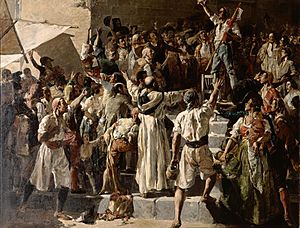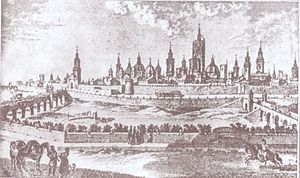Battle of Valencia (1808) facts for kids
Quick facts for kids Battle of Valencia |
|||||||
|---|---|---|---|---|---|---|---|
| Part of the Peninsular War | |||||||
 El Crit del Palleter by Joaquín Sorolla y Bastida (1884): "Yo, Vicent Doménech, un pobre palleter, li declare la guerra a Napoleó. ¡Vixca Ferran VII i mort als traïdors!" (I, Vicent Doménech, poor baker though I be, hereby declare war on Napoleon. Long live Ferdinand VII and death to traitors!) |
|||||||
|
|||||||
| Belligerents | |||||||
| Commanders and leaders | |||||||
| Bon Adrien Jeannot de Moncey | |||||||
| Strength | |||||||
| 1,500 regulars, 6,500 militia, 12,000 civilians |
8,000-9,000 regulars | ||||||
| Casualties and losses | |||||||
| unknown | 1,100-1,200 dead or wounded | ||||||
The First Battle of Valencia happened in the Spanish city of Valencia on June 26, 1808. This was early in the Peninsular War. French troops, led by Marshal Moncey, tried to capture the city. But they failed and had to go back to Madrid. This meant a large part of eastern Spain stayed free from Napoleon's control.
Contents
Why the Battle of Valencia Happened
The Peninsular War started when French armies invaded Spain. By the summer of 1808, many parts of Spain were fighting back. Napoleon thought these were just small rebellions. So, he sent small groups of soldiers from Madrid to stop them.
Marshal Moncey's Mission
Marshal Moncey was given about 9,000 soldiers. His job was to bring order back to Valencia. Moncey had two ways to get there. One was a longer, slower road through Almansa. The other was a shorter, faster path through the mountains.
Moncey believed, like Napoleon, that he was only facing a small local uprising. So, he chose the quicker mountain route.
Spanish Resistance in Valencia
The French faced a much bigger revolt across Spain. The leaders in Valencia, called the Valencian Junta, had a strong force. They had 7,000 regular soldiers and many more volunteers. These forces were ready to fight the French.
The Spanish commander, Conde de Cervellon, thought Moncey would take the easier, longer road. Because of this, the mountain passes were not well defended. Moncey easily pushed past small Spanish groups at the River Cabriel on June 21. He also got through the Cabrillas defile on June 24. He arrived outside Valencia on June 24.
The Fight for Valencia City
Valencia was not completely unprotected. Three groups of regular soldiers, helped by 7,000 Valencian volunteers, defended a spot called San Onofre. This was four miles outside the city. Don José Caro, a naval officer, led these Spanish forces.
Moncey spent most of June 27 fighting this group. He finally forced them to retreat back into the city.
Valencia's Defenses
Valencia did not have new, strong forts. Instead, it had old medieval walls and a moat filled with water around it. The land around the city was very flat. The Spanish were able to flood this area. This made Moncey's army focus their attack on only a few gates on the south side of the city.
The Spanish defenders had more people than the French. There were about 20,000 armed men in Valencia. About 1,500 were regular soldiers, and 6,500 were trained volunteers. They also had many cannons. These cannons were placed well to protect the gates. The gates were also blocked by barricades built in the days before the battle.
French Attacks on the City Gates
Moncey did not expect the Spanish to fight so hard in Valencia. On June 28, he ordered two groups of soldiers to attack the city. One group attacked the San José gate. The other attacked the Quarte gate. Both attacks failed. The French soldiers reached the barricades but could not get past them.
Moncey then tried to use his cannons to break through the Spanish defenses. But the Spanish cannons inside the city quickly stopped his guns.
Moncey then ordered a second attack. This time, three gates were attacked: San José, Quarte, and Santa Lucia. This attack was also stopped. The French had even more soldiers hurt or killed this time. Moncey simply did not have enough men to capture Valencia. The French had not planned to attack a city with strong defenses. So, Moncey's army did not have the large cannons needed for a siege.
Why Moncey Failed
After the second attack failed, Moncey knew he could not win. He also knew that the Spanish army he had avoided by crossing the mountains would soon arrive. He decided to give up on taking Valencia. He chose to go back towards Madrid.
This time, he decided to take the Almanza road. He thought there might be an open battle, which the French were sure they would win. But the Spanish moved to defend the mountain passes. They thought the French would come back the same way they came. So, the two armies missed each other again.
What Happened Next
The number of French soldiers lost at Valencia varies. Some say as few as 300, others up to 2,000. It was probably around 1,100, with 800 wounded and 300 dead. Moncey's failure at Valencia showed that the Spanish would fight very hard to defend their cities.
This defeat was soon overshadowed by a bigger French loss at Baylen on July 19. There, a French army was defeated in an open battle. But the Battle of Valencia was just as important. It ended any chance of a quick French victory in Spain.
After the Battle
The Peninsular War continued with other important events, like the First siege of Zaragoza.
See also
 In Spanish: Primera batalla de Valencia para niños
In Spanish: Primera batalla de Valencia para niños


